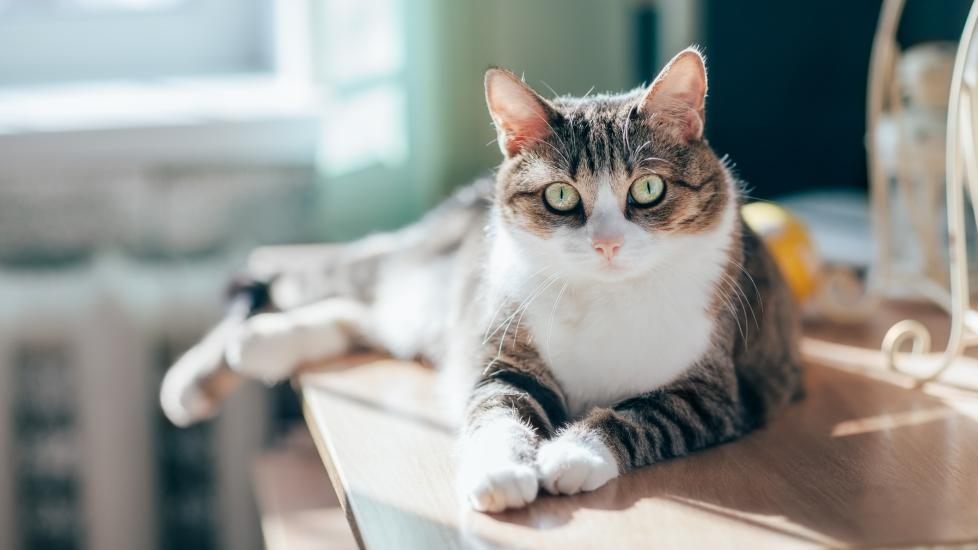Cat Acne
Viktor_Gladkov/iStock / Getty Images Plus via Getty Images
What Is Cat Acne?
If you’ve ever noticed red bumps, black dots, or dirt on your cat’s chin, your cat may struggle with cat acne, or cat chin acne.
At its basic definition, cat chin acne is a disease in which the hair follicles—typically the ones on a cat’s chin—produce too much keratin and become plugged up. This results in red bumps, blackheads, and infected pimple-like lesions.
Cats can have a single, isolated bout of cat acne, or it may be chronic.
Chronic or severely affected cats may have so many plugged follicles that they fuse together, and form swollen, painful crusts. As the lesions get bigger, the follicles are more prone to rupture, which is a sore and often messy experience. Cat acne can also lead to chronic hair loss in the affected area.
Felines of all ages can develop acne, since it’s not believed to be related to sex hormones. Additionally, cat acne affects males and females of all breeds, as well as both and neutered and unneutered cats.
Cats that eat and/or drink out of plastic food bowls may also be at risk of cat acne, as it may stem as a form of plastic allergy.
Health Tools
Not sure whether to see a vet?
Causes of Cat Acne
Cat acne is a poorly understood disorder that’s related to the overproduction of keratin, a key structure that makes up the outer layer of skin.
For several reasons, this excess keratin becomes trapped, causing the formation of blackheads, or comedones. When these blackheads become infected with bacteria, they form pustules that look like pimples.
Cat chin acne is believed to be associated with:
-
Poor grooming
-
Excessive sebum (oil) and keratin production
-
The skin’s immune-barrier function
Regardless of the underlying issue, hair follicles become blocked, resulting in infection.
How Veterinarians Diagnose Cat Acne
Veterinarians diagnose cat acne based on physical exam findings, your cat’s medical history, and the elimination of other possible skin conditions.
A skin scraping and looking at a small sample of skin under the microscope may be needed to help rule out other causes, such as mange, various skin tumors, and a condition called eosinophilic granuloma complex.
Treatment of Cat Acne
Never pick at your cat’s acne. Picking will only worsen the condition and potentially cause more pain and even infection.
Cat acne treatment begins with taking any plastic food or water bowls and changing them out immediately for stainless steel. This, along with supportive care, may be all that is needed to resolve cat acne.
Treatment may also involve the use of oral or injectable antibiotics and topical shampoo or wipes.
If your cat’s skin begins to clear, the shampoos and topical treatments can gradually be stopped.
If the outbreaks of cat acne reoccur, your veterinarian will help develop an appropriate maintenance routine to keep your cat’s chin as clear as possible.
Maintenance cleansing with gentle scrubbing has been successful for many cats because it extends the amount of time between episodes and treatment.
For most patients, improved hygiene—including washing your cat’s face and wiping your cat’s chin—is core to the treatment plan for cat acne. Your vet may recommend cleaning their face with benzoyl peroxide facial wipes, but you need to get wipes specifically made for cats, as human wipes are too strong.
Clipping the nearby fur can also cut down the number of bacteria.
Clean your cat’s water and food dishes more often and a switch to stainless steel, glass, or ceramic dishes.
Recovery and Management of Cat Acne
Cat acne is typically a superficial problem and not usually one that will have serious impacts on your cat’s overall health. Most cases of cat acne are relatively harmless and respond well with improved hygiene.
Cat chin acne does become painful if it reaches the point where lesions swell and/or scab. If this occurs, more aggressive treatment is required to manage your cat’s acne.
Prevention of Cat Acne
Cat acne can often be prevented by using non-plastic food and water bowls for your feline friend. Keep their chin clean, especially if you notice any food residue or that your cat isn’t washing themselves as often.
If you see any signs of pimples or blackheads, addressing them early will make sure the condition is unlikely to progress.
Cat Acne FAQs
How long does feline acne last?
Cat acne can be a one and done experience for some cats, or a long-standing and chronic problem lasting months or years for others.
Do cats get blackheads?
Cats can get blackheads on some parts of their bodies. This is true particularly for their chins, which is highly sensitive to blackheads and pimples.
